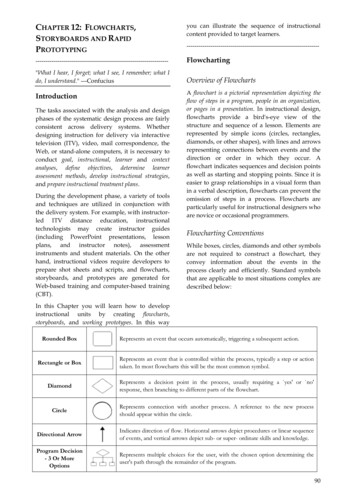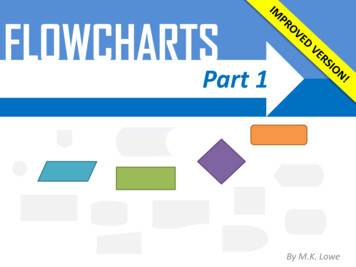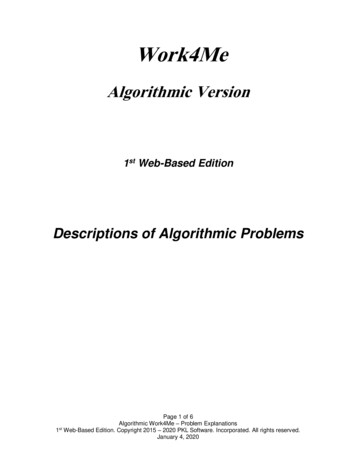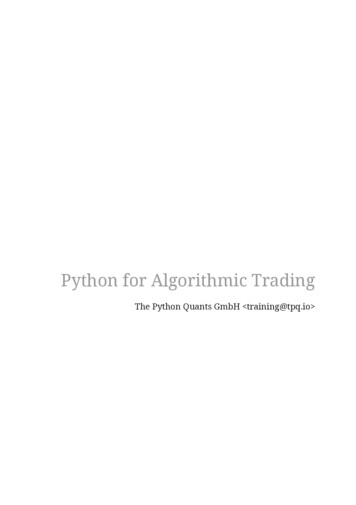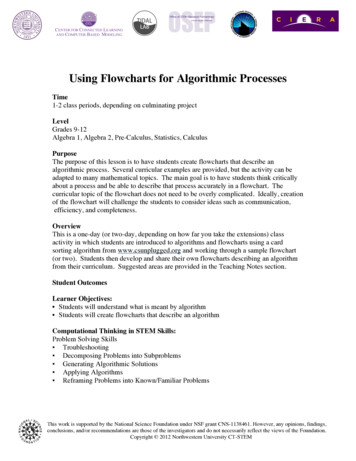
Transcription
!Using Flowcharts for Algorithmic ProcessesTime1-2 class periods, depending on culminating projectLevelGrades 9-12Algebra 1, Algebra 2, Pre-Calculus, Statistics, CalculusPurposeThe purpose of this lesson is to have students create flowcharts that describe analgorithmic process. Several curricular examples are provided, but the activity can beadapted to many mathematical topics. The main goal is to have students think criticallyabout a process and be able to describe that process accurately in a flowchart. Thecurricular topic of the flowchart does not need to be overly complicated. Ideally, creationof the flowchart will challenge the students to consider ideas such as communication,efficiency, and completeness.OverviewThis is a one-day (or two-day, depending on how far you take the extensions) classactivity in which students are introduced to algorithms and flowcharts using a cardsorting algorithm from www.csunplugged.org and working through a sample flowchart(or two). Students then develop and share their own flowcharts describing an algorithmfrom their curriculum. Suggested areas are provided in the Teaching Notes section.Student OutcomesLearner Objectives: Students will understand what is meant by algorithm Students will create flowcharts that describe an algorithmComputational Thinking in STEM Skills:Problem Solving Skills! Troubleshooting! Decomposing Problems into Subproblems! Generating Algorithmic Solutions! Applying Algorithms! Reframing Problems into Known/Familiar ProblemsThis work is supported by the National Science Foundation under NSF grant CNS-1138461. However, any opinions, findings,conclusions, and/or recommendations are those of the investigators and do not necessarily reflect the views of the Foundation.Copyright 2012 Northwestern University CT-STEM
!Common Core Standards:This activity can be used with a variety of mathematical content. Regardless of themathematical topic, the activity makes use of the following: Standards for Mathematical Practice1. Make sense of problems and persevere in solving them.2. Reason abstractly and quantitatively3. Construct viable arguments and critique the reasoning of others7. Look for and make use of structure.PrerequisitesActivities, or alternative activities, that should have been done beforeBackgroundCreating flowcharts within the curriculum should not occur on the first day of newmaterial. In order for students to successfully create flowcharts for a specific topic, theyshould be comfortable with the subject matter. For example, if this activity is to be usedwith the quadratic formula, students should have enough experience with the quadraticformula that they can focus on ensuring that their flowchart properly describes thealgorithm.Teaching Notes1. Students should work in pairs or small groups.2. Give students a pack of 10-15 playing cards. Ask them to shuffle the cardsthoroughly in order to mixed them up. Provide each group with one of the threesorting algorithms listed in the first handout (selection, bubble, or quick sort).a. Note: some groups might finish quickly, while others may take a while tofollow the algorithm. Talk to the groups who finish quickly to see whatthey noticed. Offer another of the algorithms to try.3. Once students are finished discuss the meaning of the words “algorithm” and“flowchart” as a class.a. Note: an algorithm is a set of defined steps or procedure to follow, and aflowchart is a visual representation of that process.4. Hand out the Incomplete Bubble Sort Flowchart.5. Explain the types of items in the flowchart.6. Work as a class to complete the flowchart.a. Note: oval shapes are terminators, rectangles are a process to follow, andrhombuses are questions to be asked. A possible completed flowchart isshown in the Completed Bubble Sort Flowchart document. Note that thismay not be the most efficient way to describe the flow, and this could bepart of the discussion."!This work is supported by the National Science Foundation under NSF grant CNS-1138461. However, any opinions, findings,conclusions, and/or recommendations are those of the investigators and do not necessarily reflect the views of the Foundation.Copyright 2012 Northwestern University CT-STEM
!7. Optional activity to use before students work on their own flowcharts: Have studentsfollow a completed flowchart using either the Craps flowchart or the Divisorsflowchart.a. Note: the Craps flowchart can be played with Monopoly money or candy.The purpose is to engage students in following a complicated flowchartproperly.b. Note: when using the Divisors flowchart, it is suggested that the teachernot reveal what the flowchart is supposed to accomplish (namely,determine all the divisors of the input number). Instead, ask students tofollow the algorithm and try to figure out the connection between theinputs and the outputs.8. Students make their own flowcharts for any specific topic.a. These can be done by hand or using open source software such asOpenOffice Draw or free accounts from a flowchart tool like Luicdchart(www.lucidchart.com)b. Note: The students’ flowcharts should be tested for completeness. Forexample, if students are to create a flowchart to factor a trinomial withlead coefficient of 1, the flowchart the students create should test for thatcondition.c. Students could be placed in groups of 3 to test each others’ flowcharts forvalidity/reliability.d. Additionally, encourage students to think critically about unusualsituations such as a negative number under a square root when using thequadratic formula.e. Flowcharts can then be shared with the class and discussed.Pre-class PreparationTeachers should be familiar with the given flowcharts to anticipate questions.Materials and ToolsEnough playing cards for each group to have 10 to 15 cardsAssessmentHow will the teacher evaluate if the objectives have been met?Additional InformationSuggested topics for student-created flowcharts: process for factoring trinomials multiplying binomials quadratic formula finding the slope between any two points (consider zero slope and undefined slope) Determining special quadrilaterals#!This work is supported by the National Science Foundation under NSF grant CNS-1138461. However, any opinions, findings,conclusions, and/or recommendations are those of the investigators and do not necessarily reflect the views of the Foundation.Copyright 2012 Northwestern University CT-STEM
! graphing trigonometric functions by handIntegrating using u-substitutionFinding the derivative using the chain ruleDescribing modular arithmeticHandouts begin on following page. !This work is supported by the National Science Foundation under NSF grant CNS-1138461. However, any opinions, findings,conclusions, and/or recommendations are those of the investigators and do not necessarily reflect the views of the Foundation.Copyright 2012 Northwestern University CT-STEM
Selection Sort:1.Shuffle the pack of cards.2.Place them face down on the table in a row.3.Starting with the card furthest on the left turn one card overat a time to find the minimum card in your set. After lookingat the card, turn it face down. Keep track of which card is theminimum.4.Swap that minimum card with the card in the first position.5.The first card is now in the correct position, repeat thisprocedure again, starting from the second card.6.Repeat this until no more swaps are performed.Bubble sort:1.2.3.4.5.6.7.8.Shuffle the pack of cards.Place them face down on the table in a row.Starting with the card furthest to the left, do the following:Look at the current card and the next card. If they are ‘out oforder’ (meaning the current card should be after the nextcard), swap them.Advance one card (e.g. if you just turned over the first andsecond card, now turn over the second and third card) andrepeat step #4.Continue advancing one card and swapping if necessary untilyou reach the end of the row of cards.After reaching the end of the row of cards start over at #3.Repeat this until no more swaps are performed.QuickSort:1.Shuffle the pack of cards.2.Keep the pack of cards face down in your hand.3.Turn over the top card and place it face up on the table. Thisis called your pivot card.
4.5.6.7.!Turn over the next card and place it face down to the left orright of your pivot card depending upon whether it is lessthan or greater than the pivot card.Continue this process through the entire pack.Pick up one of the face down packets of cards and repeat theprocess starting at #3 using a new pivot card from your facedown packet.Repeat this process the remaining face down packets until allcards are face up.
Pick a positivewhole number MSET D 2SET N 0Divide M by DAdd 1 to DSet M equal tothis new valueMultiply M by DIs M whole?YESAdd 1 to NNOIs M 1?YESOUTPUT NNOSet M equal to thisnew value
Bubble sort: 1. Shuffle the pack of cards. 2. Place them face down on the table in a row. 3. Starting with the card furthest to the left, do the following: 4. Look at the current card and the next card. If they are ‘out of order’ (meaning the current card should be after the next card), swap them. 5. Advance one card (e.g. if you just turned over the first and

